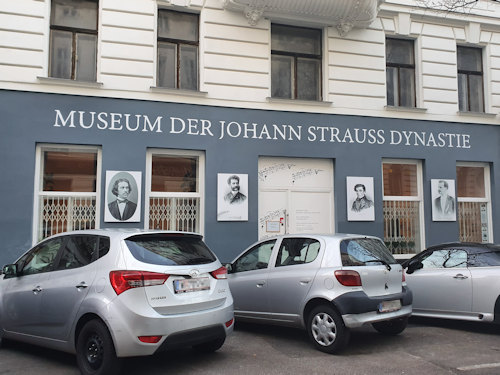The museum has closed down, unfortunately, but consider visiting the Strauss apartment or House of Strauss (Casino Zögernitz) as alternatives.
Here’s what I had to say about the old museum before confirmation of the long-term closure…
Previous review:

The music of 19th-century Vienna still echoes around the concert halls and ballrooms of the world. And the Strauss family composed a fair amount of it. The Strauss Museum takes you on a journey through their lives and the world they lived in.
- A comprehensive collection of pictures, documents and memorabilia, curated into themes
- Numerous audio stations let you enjoy the music while exploring the Strauss world
- Also introduces you to political, social, municipal, and technological developments of the time
- Exhibit and background information all available in English, too
- See also:
Four composers, one museum

(Sadly, closed)
Before Austria’s national football team emerges onto the pitch, the crowd swings flags to the tune of the Radetzky March by Johann Strauss I.
When the chimes of the Stephansdom bell finish announcing the dawn of a the new year, TV and radio stations play The Blue Danube waltz by Johann Strauss II.
The programme of the 2020 New Year’s Concert by the famous Wiener Philharmoniker orchestra featured polkas by both Eduard and Josef Strauss.
In other words, the light classical music created by Johann Strauss I and his three sons continues to charm and entertain the world today. And if you want to learn more about the dynasty, there’s no better place than Vienna’s Strauss Museum.
This private initiative groups its exhibits into 15 themed sections.
Each section comes with a booklet with English translations of all the German display text. More importantly, each section also comes with a music station and headphones, so you can listen to a selection of Strauss music throughout your visit.
The museum features a wide variety of documents, photographs, sheet music editions, pictures and memorabilia, all accompanied by detailed information on the Strauss family and the times they lived though.
The displays often tie the biographies and works of the four men to the sociopolitical context and takes little excursions into architecture, technology, and other topics.
So you learn much about 19th-century Viennese life and entertainment. It’s also rather intriguing to see how much of the music piggybacked on events or used appropriate dedications to raise the composer’s profile. For example:
- Strauss II’s Rotunde-Quadrille, named in honour of the main building at the 1873 World Exhibition in Vienna
- Or his Durchs Telephon polka, which addresses the development of the telephone
- Strauss I’s 1843 Ferdinand Quadrille, named after the emperor
And while the focus is (obviouly) on the four Strauss men, other composers of the time, such as Joseph Lanner, get a fair bit of attention too.
The overall impression is one of a labour of love; a collection curated with care and respect for its subjects. All the objects come from a private collection, assiduously put together over 25 years of endeavour by Prof. Helmut Reichenauer, President of the Wiener Blut association behind the museum.
Those with any kind of interest in the Strauss family will find the museum an utter joy.
Highlights
I’m no classical music buff, even though it seeps into your veins automatically when you spend a decade or two in Vienna. But two particular highlights for me were:
- The many pictures of 19th-century Vienna, which make a fascinating contrast to today’s city. For example, pictures of the Volksgarten park area (a popular concert venue back then) before the removal of the city fortifications and construction of the city’s Ring boulevard.
- A copy of the paper that announced the first appearance ever of Johann Strauss II with his orchestra in 1844 – this is one of many items that open a deeper connection to the musical past.
Tickets & visitor tips
According to the last news I saw at the official website (which had gone offline at the time of writing), the museum was closed, but hoped to reopen in 2022 at a new location. Check for yourselves locally for the latest news.
As an alternative, consider the Wien Museum’s Strauss apartment or the House of Strauss.
How to get to the Strauss Museum
Note: these are directions to the old location, which I’ll update if and when the new museum opens.
Subway: the nearest station is probably Roßauer Lände on the U4 line. But it might be easier to reach Schottentor on the U2 and take one of the below trams from there.
Tram/bus: pick up a 1 or D tram from one of the Ring stops and continue to Schlickgasse.
Although tucked a little away from the bustling centre, the Strauss Museum has a famous neighbor: a short walk takes you to the Sigmund Freud Museum.
Current (closed) address: Müllnergasse 3, 1090 Vienna